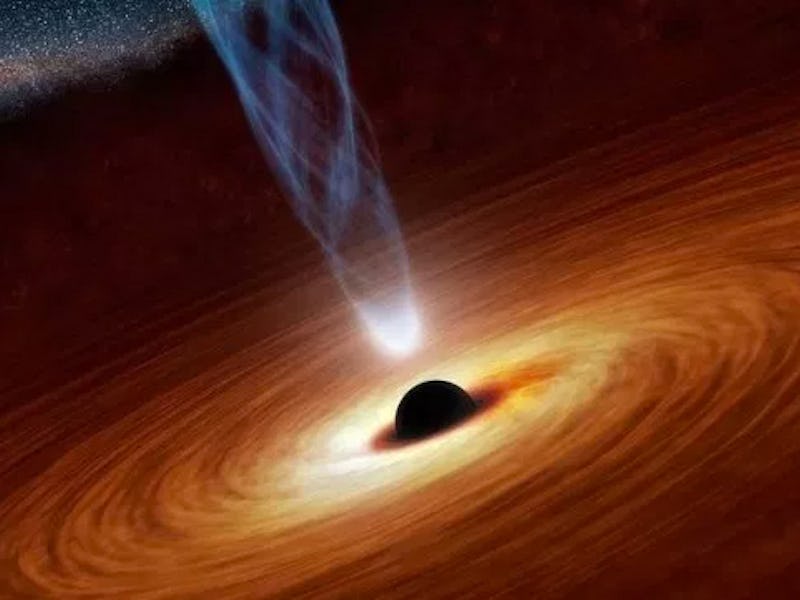This Supermassive Black Hole Has 2.25 Billion Times the Mass of Our Sun
This galactic gargantua lies 100 million light-years from Earth

Using the Atacama Large Millimeter/submillimeter Array (ALMA) in northern Chile, astronomers have captured an extraordinary glimpse of a huge swirling disk of cold, dense interstellar gas rotating around a supermassive black hole.
This disk lies at the heart of NGC 3258, a massive elliptical galaxy about 100 million light-years from Earth. A paper detailing this discovery was published on Wednesday in The Astrophysical Journal. From these new observations, the international team of astronmers behind the study concluded that this black hole has 2.25 billion times as much mass as our sun, making it by far the biggest black hole measured by ALMA to date.
“Observing the orbital motion of material as close as possible to a black hole is vitally important when accurately determining the black hole’s mass,” Benjamin Boizelle, a postdoctoral research associate at Texas A&M University and the paper’s first author, said in a statement. “These new observations of NGC 3258 demonstrate ALMA’s amazing power to map the rotation of gaseous disks around supermassive black holes in stunning detail.”
Illustration showing the ring of dust and gas with the supermassive black hole in the center. The disk is almost a thousand light years across
In essence, a black hole is a dead star that’s collapsed in on itself. It has such a strong gravitational field that it pulls in everything within its grasp: gas, interstellar dust, and even light. The pull is so strong that even time is distorted the closer you get to the edge, which is called the event horizon. The mysterious allure of these magnificent monsters was further fueled when it was announced in 2018 that a supermassive black hole lay at the center of our own galaxy — in a region called Sagittarius A* — and more than likely, there was one at the center of every galaxy.
Astronomers can adopt a number of techniques to determine the mass of a black hole. “In giant elliptical galaxies, most measurements come from observations of the orbital motion of stars around the black hole, taken in visible or infrared light,” reads a statement from the National Radio Astronomy Observatory. However, researchers at ALMA developed a new way in which to study black holes in giant elliptical galaxies:
About 10 percent of elliptical galaxies contain regularly rotating disks of cold, dense gas at their centers. These disks contain carbon monoxide (CO) gas, which can be observed with millimeter-wavelength radio telescopes.
By using the Doppler shift of the emission from CO molecules, astronomers can measure the velocities of orbiting gas clouds, and ALMA makes it possible to resolve the very centers of galaxies where the orbital speeds are highest.
“Our team has been surveying nearby elliptical galaxies with ALMA for several years to find and study disks of molecular gas rotating around giant black holes,” said Aaron Barth, Ph.D., a professor of astronomy and physics at UC Irvine and a co-author on the study. “NGC 3258 is the best target we’ve found, because we’re able to trace the disk’s rotation closer to the black hole than in any other galaxy.”
Disney's 'The Black Hole' brought the cosmic curiosities to the public's attention
Black holes have captured the imagination of just about every space buff and sci-fi fan ever since they first entered mainstream pop-culture in the late 1970s. In fact, before Disney’s The Black Hole was released in 1979, very few people outside of cosmological circles had even heard of a black hole.
Granted, some artistic license was taken in The Black Hole — it’s regarded as one of the most scientifically inaccurate sci-fi movies ever made — but it brought these fantastic phenomena to the public’s attention, inspiring the imagination of young science fiction readers and writers everywhere. The main spacecraft in the movie is even called the Cygnus, named after the very first black hole that was acknowledged to exist in 1973. Since then they’ve popped up a number of times, on both the big and small screen, from Stargate: SG1 to Sphere to Interstellar.
A black hole's gotta go somewhere, right? The fabric of spacetime.
The most perplexing question is Where do they lead to? If you consider, as Einstein postulated, that spacetime is like a giant piece of fabric, held taut, then it’s easier to visualize a black hole. But all the matter that gets sucked into a black hole still has to come out somewhere, right? Unfortunately, no one has been able to fly into one, so we still don’t have an answer to that question. Even if they did, they’d face an unpleasant demise in a process called spaghettification.
However, that hasn’t stopped sci-fi writers from using black holes as a method to travel vast, interstellar distances, safely popping out the other end somewhere, in a different part of the universe. This is similar, but slightly different to another Einstein theory, something called an Einstein-Rosen bridge, more commonly known as a wormhole.
ALMA’s observations of NGC 3258 don’t shed any new light on where it might eject its material, but as astronomers inch closer to directly observing black holes through the clouds of gas that surround them, perhaps one day they will find out.